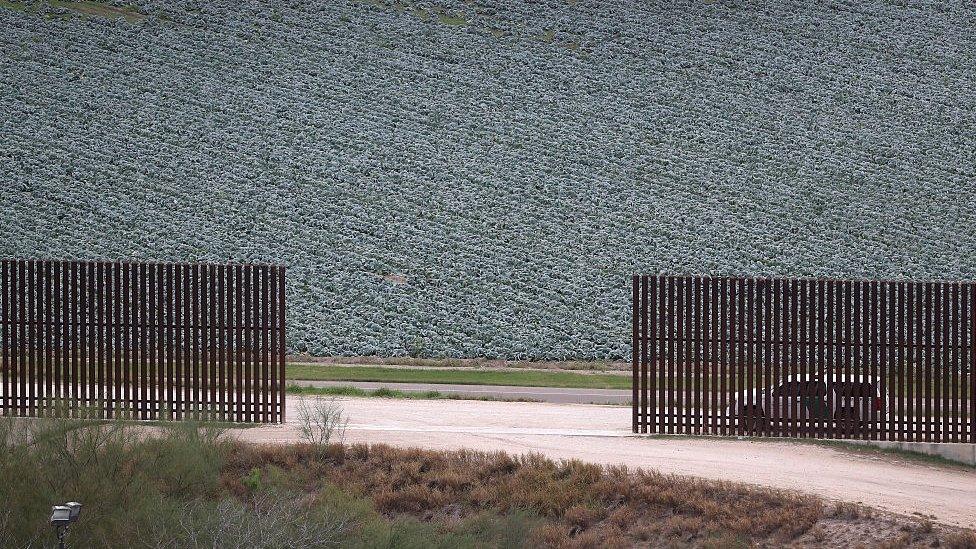Trump's divided desert: Wildlife at the border wall
- Published
Victoria Gill joins scientists working in the Sonoran Desert
President Trump's promise to build a "great wall" along the US-Mexico border remains one of the central and most controversial promises of his presidency. But scientists from the University of Arizona are starting to unravel the effect that such a wall could have on a desert ecosystem it will cut through. The team is studying wildlife in the Sonoran Desert, which stretches across the border from Arizona into Mexico and is already divided by a barrier at the border. BBC science reporter Victoria Gill joined the team in a search for some of the desert's most endangered animals.
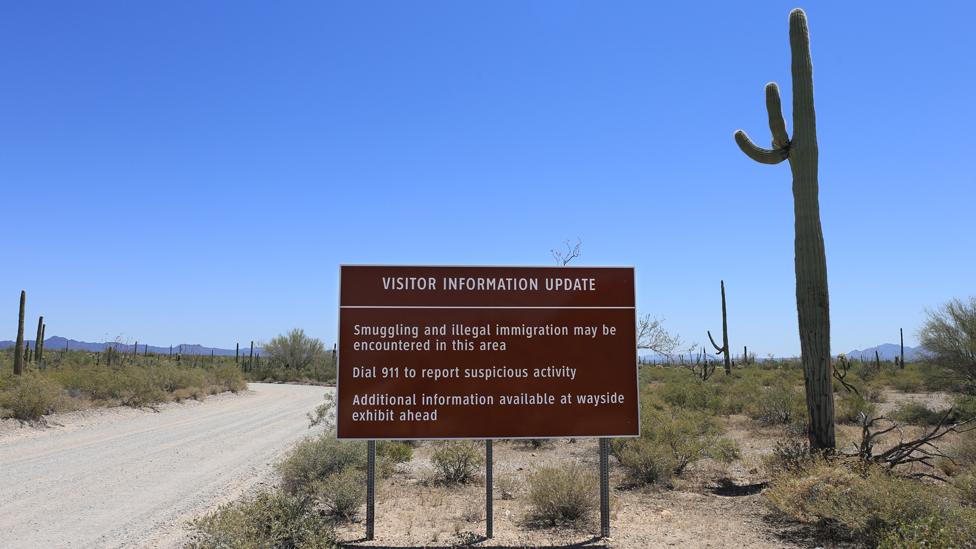
The landscape of Organ Pipe Cactus National Monument meets the international border
Its proximity to the border gives Organ Pipe Cactus National Monument, external a dangerous reputation.
But as you bump along dirt roads of this set-aside swathe of the Sonoran Desert (and if you do not tune in to the pre-recorded park radio announcement that warns of "illegal activity related to proximity to the international border"), it is the wild beauty of this landscape that hits you first.
Forests of tall saguaro cactus stand with arms stretched upward - seemingly triumphant - silhouetted against the rising Sun. These impressive, swollen plants can grow 20m (65ft) in height - sucking up and storing liquid from bursts of rainwater that can fuel an impressive two centuries of prickly growth.
But I am here with my friendly and almost intimidatingly competent PhD student host Stephanie Doerries and her softly spoken colleague Andrew Antaya - looking for some much more elusive desert life. We're in search of endangered Sonoran pronghorn.
"There are only 228 individuals in 800,000 hectares (two million acres), so they can be quite difficult to find just by going to a hilltop," Stephanie says.
That's why she and Andrew take their somewhat desert-ravaged truck, which is packed full of camping gear, scientific equipment and a huge cooler of ice-cold water, out into the desert at dawn. The fleeting cool of first light can be the best time to catch a glimpse of these shy creatures.

Andrew and Stephanie often spend hours searching for the wildlife they are studying
Sonoran pronghorn are unique to the North American continent - in a different family from antelope that roam the plains of Africa. They are found throughout North America, but the Sonoran subspecies lives only in this desert.
Their evolutionary race with the now extinct American cheetah made them the fastest land animal on the continent.
But they are built for distance as well as speed - each individual could have a home range as large as 2,800 sq km (almost 1,000 sq miles), as they walk the arid landscape foraging for leaves and cactus fruit.
Their critically low numbers and their cross-border range have made this animal a central character in the ongoing discussion about the impact of President Trump's promised "impassable" border wall.

Human activity is often not evident in this wild landscape
As Stephanie and Andrew's trackers pick up the faint "blip, blip, blip" of a nearby radio-collared pronghorn, they both peer intently and silently through their scopes.
In these wide desert plains, the small hill we have climbed gives a clear view several kilometres in every direction.
"I got them," Stephanie says, triumphantly.
Only with her expert help - lining up the view perfectly through her scope - do I manage to catch a glimpse of a female with her delicate, twin fawns. Pronghorn typically have twins.
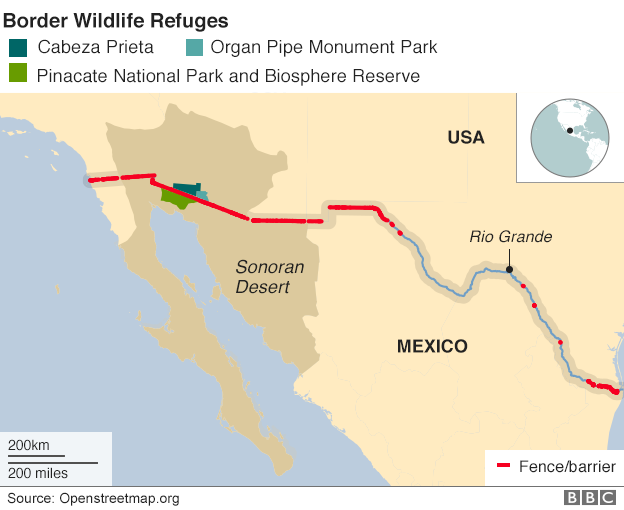
Stephanie begins to make meticulous notes. Is she standing or lying down? Alert or resting? In which direction is she moving?
"What we can hopefully help to understand," she says, "is what it's like to be a pronghorn in the Sonoran Desert along the US-Mexico border. What happens when you encounter humans or vehicles on the landscape?"
Stephanie has much more data to collect before she and her colleagues can draw out a clear answer to this. She will spend hours just finding an animal before she can begin watching and recording its behaviour. But initial data suggests that pronghorn do respond differently to human disturbance than to "more natural disturbances". And if these disturbances take the animals' attention away from foraging or from looking out for predators, that could be lethal.
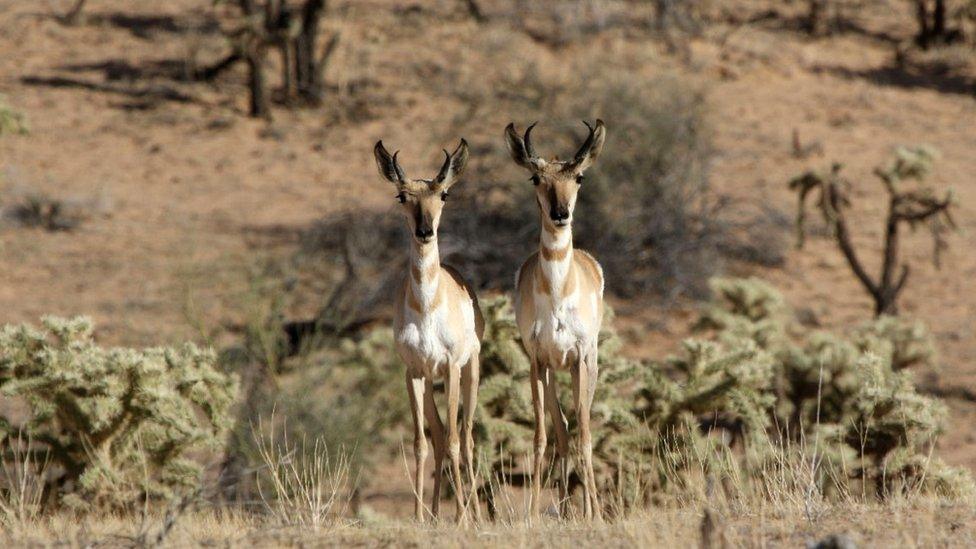
There are just 228 Sonoran pronghorn estimated to be in the US
People are not an obvious feature of the landscape here - on hiking trails and stunning mountain drives, the views are of arid, empty wilderness. But Organ Pipe Cactus National Monument stretches right up to the US-Mexico border, and that location brings a level of human activity.
US border patrol trucks are on the move here constantly, checking the border fence and dragging large tyres that smooth out the dirt track and make border crossers' footprints easy to spot.
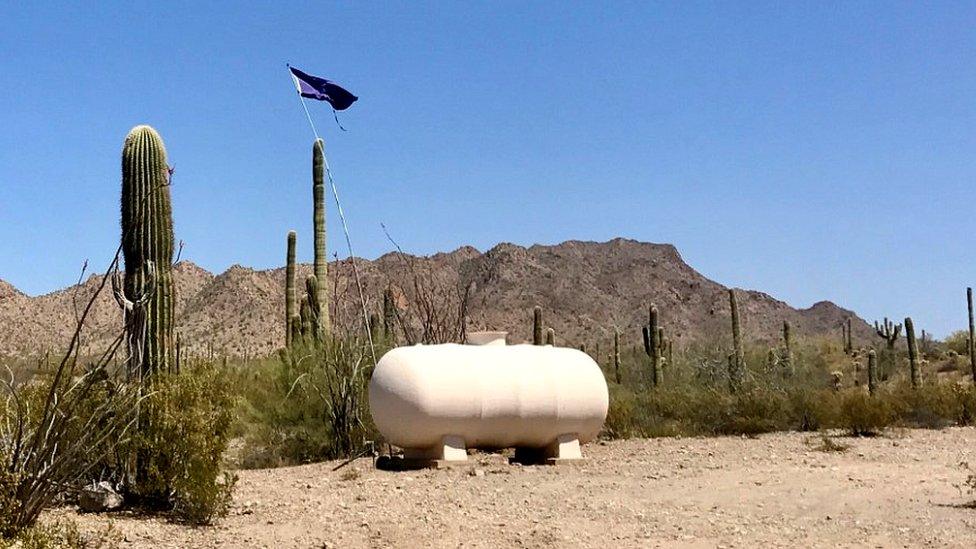
Humanitarian water supplies for border crossers are marked by purple flags
Purple flags demarcate water supply tanks, where those who head north and into the US desert on foot, can find a potentially life-saving drink. Stephanie hikes and camps alone in the desert on a regular basis and she has seen and even crossed paths with groups of people who were walking north.
"In three years of field work," she says, "I've encountered border crossers twice on foot and we simply avoided each other. While driving, I've encountered two groups waiting along the roadside for assistance. I stopped a safe distance away and left water in the road for them.
"I've also observed border crossers on about half a dozen occasions while scanning my surroundings from an observation point."
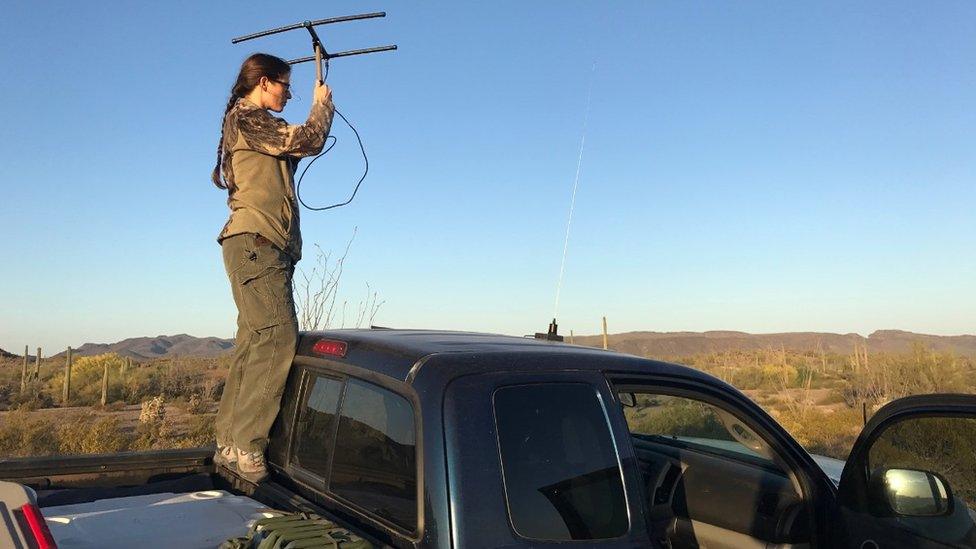
Stephanie Doerries uses her truck bed for a vantage point to scan for radio-collared pronghorn
Divided Desert
The most obvious human disturbance here though is the structure that cuts right through Sonoran pronghorn range - the physical barrier at the international border.
The protected land of Organ Pipe Cactus National Monument includes about 50km (30 miles) of the international border. On either side of the official crossing point, at the tiny US entry port of Lukeville, there is a high pedestrian fence. It is a tight, metal grill structure about 7m (23ft) high and is just 8km (five miles) in length. Beyond that, stretching out towards the mountains, is a low vehicle barrier.
Stephanie's supervisor and the lead researcher on the pronghorn study, Prof Dave Christianson, external, from the University of Arizona, shows me the point at which the high, impermeable fence ends.
It is a strange sight; the imposing fence stops abruptly. And standing by the low barrier - designed to be permeable for wildlife but to stop cars driving into the US desert - you can quite easily poke your toe through the wide gaps between the posts and have one foot in each country.
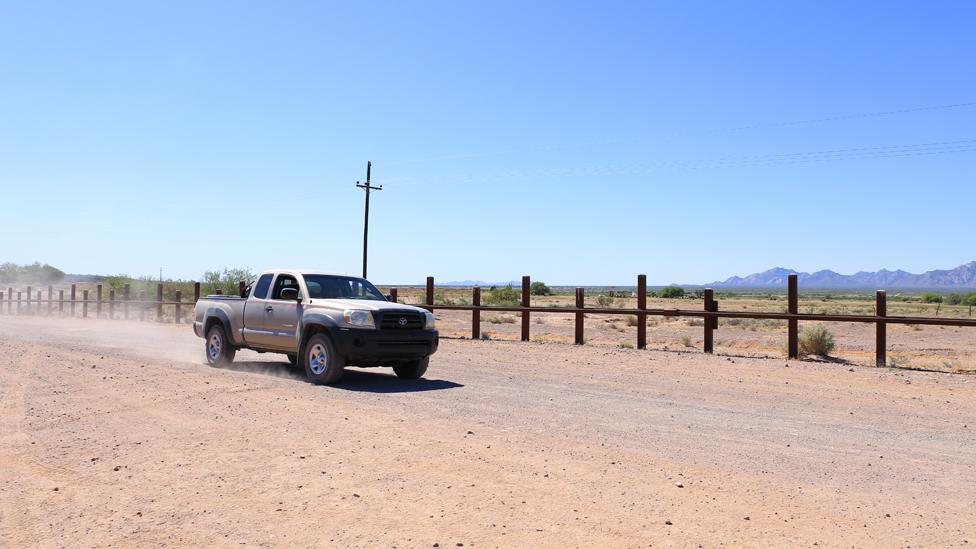
The vehicle barrier is designed to stop cars, but to be permeable for wildlife
Standing by this low barrier, scanning the surroundings, Dave points out how unproductive this harsh, hot landscape appears to be.
"But we find hundreds of species that evolved not just to survive here, but to thrive," he tells me. Those species all evolved long before any fence was built, but the fence itself is what has made this area such a fascinating ecological experiment.
"When human beings suddenly change the landscape like this, it's a great opportunity to be paying attention, and to see what happens," Dave says.
So how much of an impact could severing the connection with Mexico have on the species he studies?
"Potentially a very, very large impact," he says. "Pronghorn still attempt to cross the border, but a barrier here is likely cutting off a large part of pronghorn range that they need to survive.
"That's critical, because for species like pronghorn - large animals that need to move - being able to go where the forage is and where mates are is a critical part of their survival."
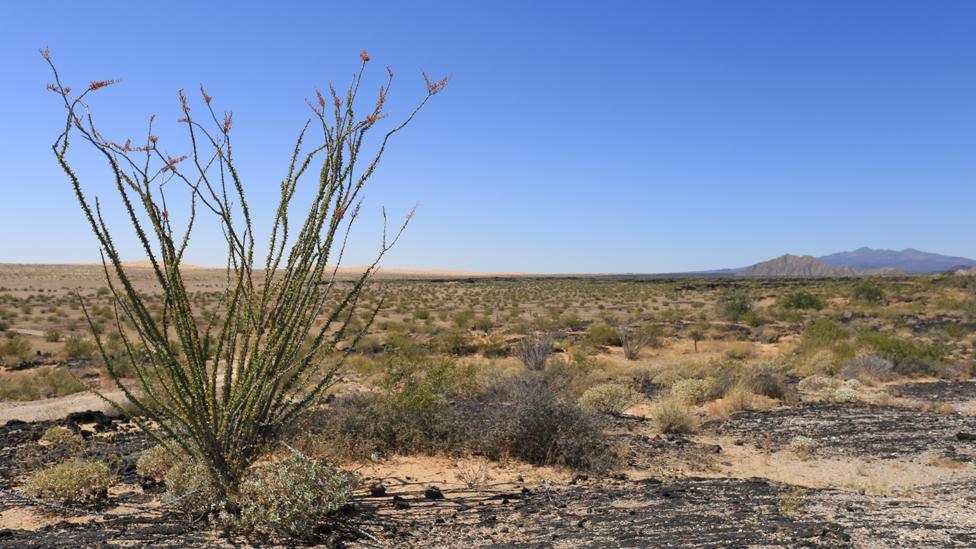
To forage in this dry habitat, large herbivores need to roam over large distances
Importing Mexico's animals
The US government has spent more than a decade investing in the conservation of endangered Sonoran pronghorn.
In the nearby Cabeza Prieta National Wildlife Refuge, the US Fish and Wildlife Service runs a captive breeding programme, centred on a large desert pen for the animals. This was built following a devastating drought that saw the number of US Sonoran pronghorn fall to just 21 animals.
Animals from Mexico have been brought across the border and into the pen for this programme. And each year a few carefully selected adults are released to supplement and help sustain the wild population.
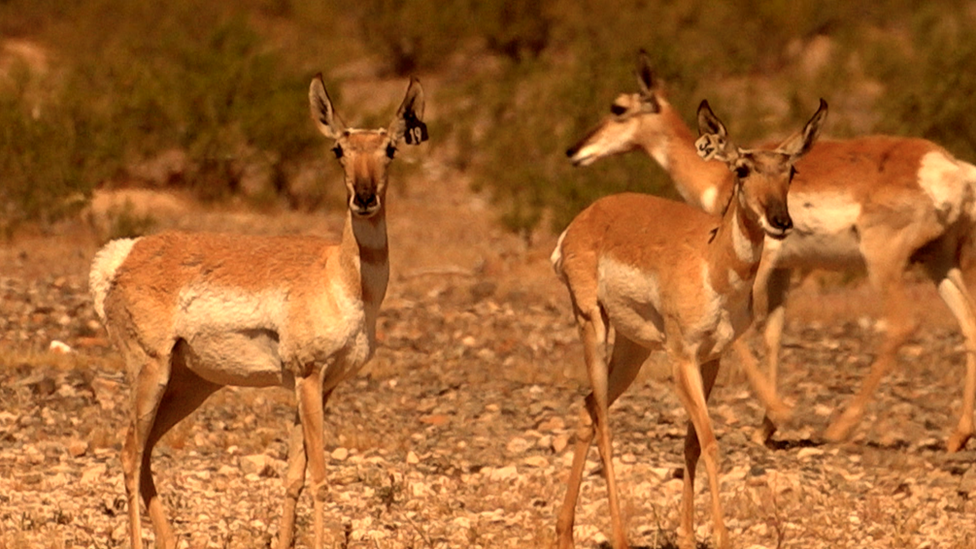
Ear tags identify pronghorn that have been released from the captive breeding programme
According to the wording of the executive order President Trump issued in January, external this year, the low "wildlife-friendly" fence could soon be replaced with a "contiguous, impassable physical barrier". And, Dave says, this would cut off vital pronghorn range altogether.
Speaking at the Conservative Political Action Conference in February, President Trump reinforced his promise, external that "we're building the wall, don't you worry about it", to chants of support from the audience. "In fact," he added, "it's going to start soon. Way ahead of schedule."
With little visible progress more than three months later, a legal obstacle - also with its origins in Arizona - has since threatened to slow his plan.
In April the Center for Biological Diversity and congressman Raul M Grijalva, external sued the Trump administration over its proposed border wall. Their suit called on federal agencies to conduct an "in-depth investigation of the proposal's environmental impacts".
Despite this, and amid a cloud of scandal surrounding the Trump administration, t, external that will be asked to submit design proposals for the new border wall. When I asked the Office for Customs and Border Protection, external whether semi-permeable barriers - designed to mitigate the impact on wildlife of the existing border fence - would be replaced with the impassable barrier prescribed by President Trump's executive order, the response was equivocal.
"We cannot address future construction," said a representative, but "I can tell you that the environment has been one of the main considerations on previous construction projects".
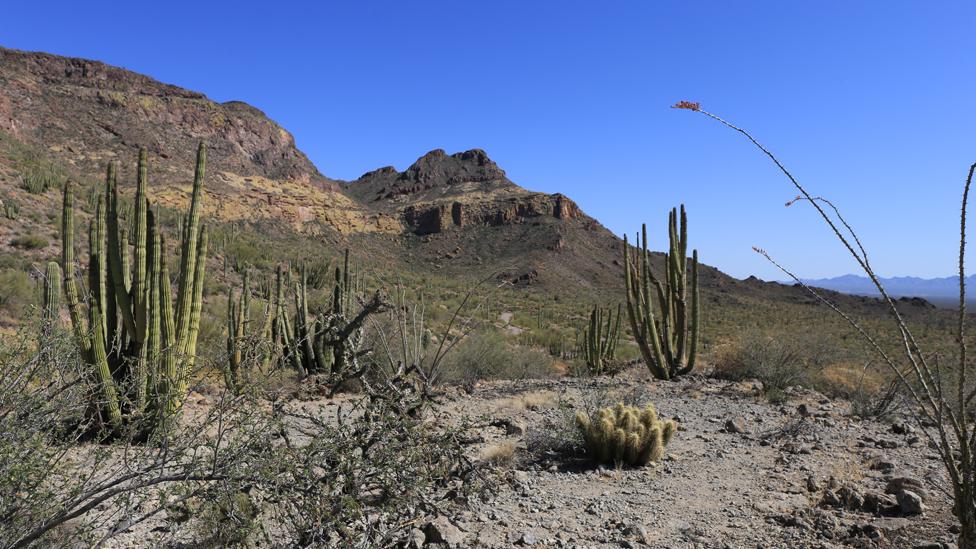
Organ Pipe Cactus National Monument takes its name from the impressive cactus that litter its plains
Science without borders
I go along with my University of Arizona hosts across the border to Mexico, where they introduce me to their collaborator in the neighbouring Pinacate reserve.
Miguel Grageda is the natural resources management coordinator at the reserve - a Unesco World Heritage site, external.

Miguel Grageda has been collaborating with the Arizona team for two years
After spending the day on the US side of the desert - searching for pronghorn until late in the evening - it is dark by the time we reach the reserve, so we head straight to our campground, with a plan to start our exploration on this side of the border early in the morning.
Miguel is responsible for monitoring many of the species of animals and plants in the reserve. But listed, endangered species are his key focus, and what the researchers call a "biological corridor" - for both the pronghorn and the aptly named bighorn sheep - spans the border. Both species range over wide areas to find food.

Bighorn sheep also range across the Sonoran Desert
Miguel has been working with the Arizona team for the past two years, helping gather genetic information - from samples of animals' droppings - that could ultimately reveal how much interbreeding there is between the groups of animals across the border.
Genetic mixing gives species the biological armour to adapt to environmental changes or disease, so it is also crucial for their long-term survival.
"There is a highway along the borderline, and that has already affected the relationship between the populations of these animals in the US and Mexico," Miguel tells me. "And now this new issue - the wall they want to build along the border, which is also going to be a limit.
"These animals need to move all the time… and they have become trapped in the reserve."
As Miguel and Dave chat quietly, they share their concerns that, in future, the logistics of their international collaboration may become more difficult. And Miguel does not hold back with his view on the construction of a new border wall.

For some animals, including this vulture, a wall will not be an obstacle
"The pronghorn don't know where one country ends and another starts," he says. "They don't know about boundaries. So to me having a wall makes no sense.
"That won't stop the social problems, but it will increase the problems for wildlife - on both sides of the the line; not just in Mexico, but also in the United States."
We pack up our tents and head out into the reserve, with Miguel advising Dave about where we might have the best chance of seeing bighorn sheep - an even rarer sight than the pronghorn.
Dave and the team will have to wait to see whether there will be a new structure for them to study in this desert - a wall that would slice this precariously connected habitat in half.
- Published27 April 2017
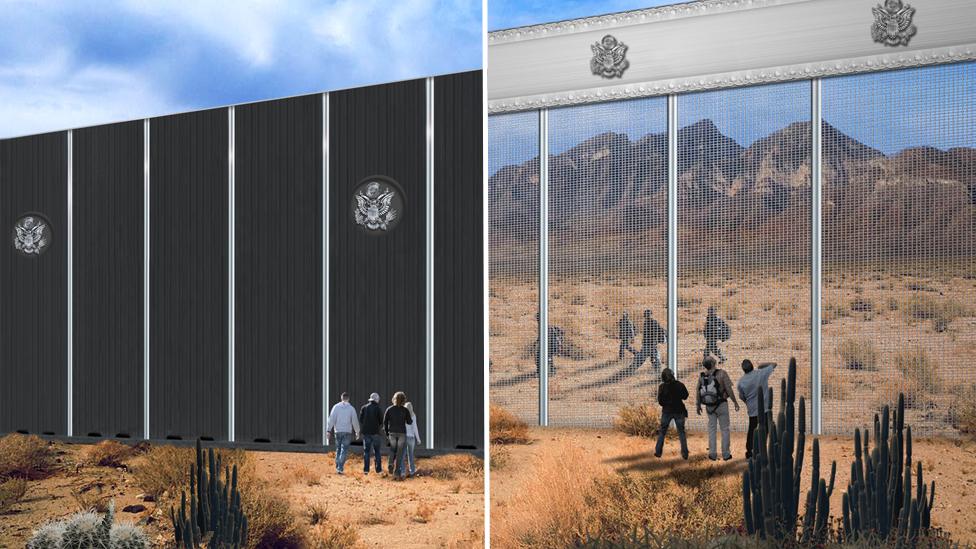
- Published23 February 2017
